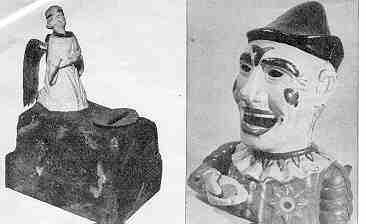Penny Banks
By MURIEL ANDERSON, CHILDREN'S ACTIVITIES, September, 1956
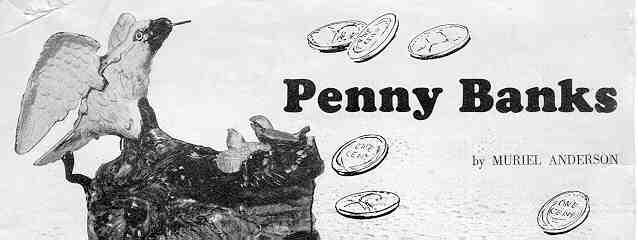
HAVE you ever slipped a penny into an old-fashioned mechanical bank and
watched it work? Then you know what fun it was. And no wonder it was fun because the
people who devised these banks had marvelous imaginations. They made banks in the form of
human beings, animals, birds, fish, and so on. And the creatures did all sorts of things.
There seemed almost no limit to the originality of the inventors.
Mr. John Johannsen, of Wauwatosa, Wisconsin, has a collection of over eight hundred
different penny banks. Where did he get them? Some he found in antique shops; others
through the advertisements in collectors' magazines or in newspapers. Still others he
discovered at Salvation Army or Goodwill stores.
In order to display his banks to advantage, he has provided a special place for them in a
second-story room of his home. Almost this entire room is lined with shelves for display
purposes.
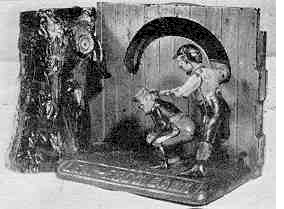 But Mr. Johannsen believes that his banks should be enjoyed as well as looked
at. So he often invites boys and girls to visit his collection. A jar of pennies stands on
the table where he demonstrates his banks. Occasionally Mr. Johannsen is invited to give a
talk about his hobby at one of the local schools. He has also exhibited his collection at
the art gallery in Milwaukee and appeared on several television programs.
But Mr. Johannsen believes that his banks should be enjoyed as well as looked
at. So he often invites boys and girls to visit his collection. A jar of pennies stands on
the table where he demonstrates his banks. Occasionally Mr. Johannsen is invited to give a
talk about his hobby at one of the local schools. He has also exhibited his collection at
the art gallery in Milwaukee and appeared on several television programs.
"Which of the banks is the favorite with children?" I asked the day that I
visited the collection.
"There are many favorites," Mr. Johannsen replied. "But one that all
children seem to enjoy is this Monkey and Coconut bank."
He put a penny in the monkey's paw, pressed a lever, and the coconut opened and took the
penny. The monkey rolled his eyes and opened his mouth as if to say "Thank you."
"Here is one that boys especially seem to like," said Mr. Johannsen, taking his
Leapfrog bank from a shelf.
When he dropped a coin into the trunk of a tree, two young boys began to play leapfrog.
"Young people are always enthusiastic about this one, called Bad Accident," Mr.
Johannsen said.
He put a penny under the driver's seat, pressed a lever, and quick as a wink a boy darted
out from behind a bush. The boy frightened the donkey; and it reared, upsetting the cart
and driver.
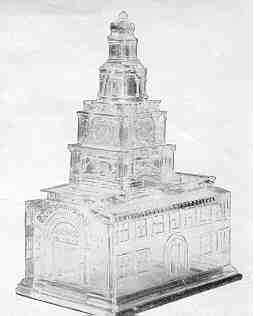 One that has a popular appeal is the Eagle and Eaglets. When a penny was put into the
mouth of the mother bird and a lever pressed, she bent forward with spreading wings. The
young birds opened their bills, chirping at the same time; and as the mother bird bent
down still farther, the penny fell into the nest.
One that has a popular appeal is the Eagle and Eaglets. When a penny was put into the
mouth of the mother bird and a lever pressed, she bent forward with spreading wings. The
young birds opened their bills, chirping at the same time; and as the mother bird bent
down still farther, the penny fell into the nest.
The smallest bank in the collection hardly looks like a bank at all. It is a tiny thing
about as big as a candy mint. It is made of silver and holds ten dimes. It was to be worn
on a chain around the neck and was intended for a Sunday-school bank.
The largest bank in the collection is a replica of a big safe such as used in offices. It
is a cubic foot in size and opens with a combination lock. The owner of this bank either
had to have a good memory or keep the combination written down in some safe place.
I asked Mr.Johannsen which was his favorite bank.
"I guess I treasure my Mission Bank most," he replied. "It is a very rare
bank. In fact, I've never found it listed in any collectors' book."
This bank has a kneeling angel, who nods her head in thanks when a coin is
dropped into the slot of a golden plate on the grassy hill where she kneels.
One of the reasons this is his favorite bank is that it reminds him of his childhood in
Germany. The little church to which he belonged had a similar bank, with a little Negro
boy, kneeling, instead of the angel. The children used to put money into this bank for
foreign missions.
When Mr. Johannsen and his wife visited Germany in 1952, they returned to this little
church. The bank was still there, and on Sunday mornings the children were still putting
in their coins for foreign missions.
Mr. Johannsen has never been able to find another bank like this. But the one with the
kneeling angel is nearest like it.
Penny banks first appeared in America in 1793 along with the first big copper
pennies. These early banks were made of pottery, glass, or wood. They were
"still" banks, not mechanical ones. Many times they came filled with honey or
tea, and the children had to wait until the containers were empty to use them. Sometimes
the banks had to be broken to remove the money.
Tin banks came next, then cast-iron ones. By this time inventors were making mechanical
banks, and most of them were made of cast iron.
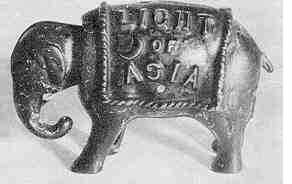 Mr. Johannsen has many still banks in his collection. One particularly fine one is a
Stiegel glass reproduction of Independence Hall, in Philadelphia. It was made in 1875 and
is a three-mold bank instead of the more common two-mold type. Because of this it is more
valuable as a collector's item.
Mr. Johannsen has many still banks in his collection. One particularly fine one is a
Stiegel glass reproduction of Independence Hall, in Philadelphia. It was made in 1875 and
is a three-mold bank instead of the more common two-mold type. Because of this it is more
valuable as a collector's item.
Some of the other still banks include Uncle Sam's Hat, which is made of glass; Beehive,
made of milk glass and, in the beginning, containing honey; and some Pennsylvania Dutch
chalk banks. One of the oldest still banks is the Wooden Shoe, made of delftware.
Like other collectors' items banks often become more valuable as time goes on. One bank,
called Light of Asia, is now valued at $150.00. It is in the form of an elephant that nods
its head in thanks when a coin is inserted in the slot.
In ancient Greece pottery urns were used to hold money. Pottery and porcelain
banks were known in Europe at a very early date. The first mechanical bank is thought to
be an Alms Box, belonging to the Han Dynasty (206 B.C.-220 A.D.) in China. This bank is
made of porcelain. It is now in the Metropolitan Museum of Art in New York City.
"Do you think children still enjoy saving pennies in toy banks?" I asked.
"Oh, yes!" Mr Johannsen replied, smiling. "I guess children will always
enjoy penny banks." He pointed to a shelf where he keeps the toy banks of today, most
of them of plastic. "Some day," he added, "I suppose these will be
collectors' items."
